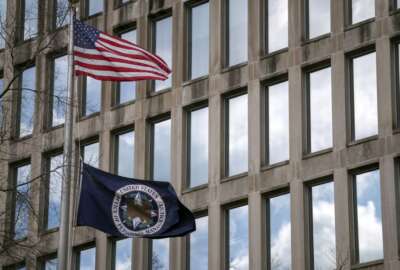Exclusive
Mayorkas details DHS workforce gains, future plans
DHS improved in the 2023 Best Places to Work rankings. In a sit-down interview, DHS Secretary Alejandro Mayorkas tells Federal News Network how it happened.
Editor’s Note: This story is part of a DHS special report for Federal News Network. Check back for more interviews and content about DHS’ workforce engagement and satisfaction efforts throughout the week.
Homeland Security Secretary Alejandro Mayorkas says his department’s advancement in the federal government’s workplace rankings did not happen by accident.
Instead, Mayorkas said the Department of Homeland Security climbed out of the bottom of the Partnership for Public Service’s Best Places to Work in the Federal Government rankings over the past two years because officials have been “intensely engaged” on workforce issues.
“It is the product of significant focus on employee wellbeing and investing in our workforce in a number of different ways,” Mayorkas said in an exclusive interview with Federal News Network. “We really have made the wellbeing of our workforce our top organizational priority.”
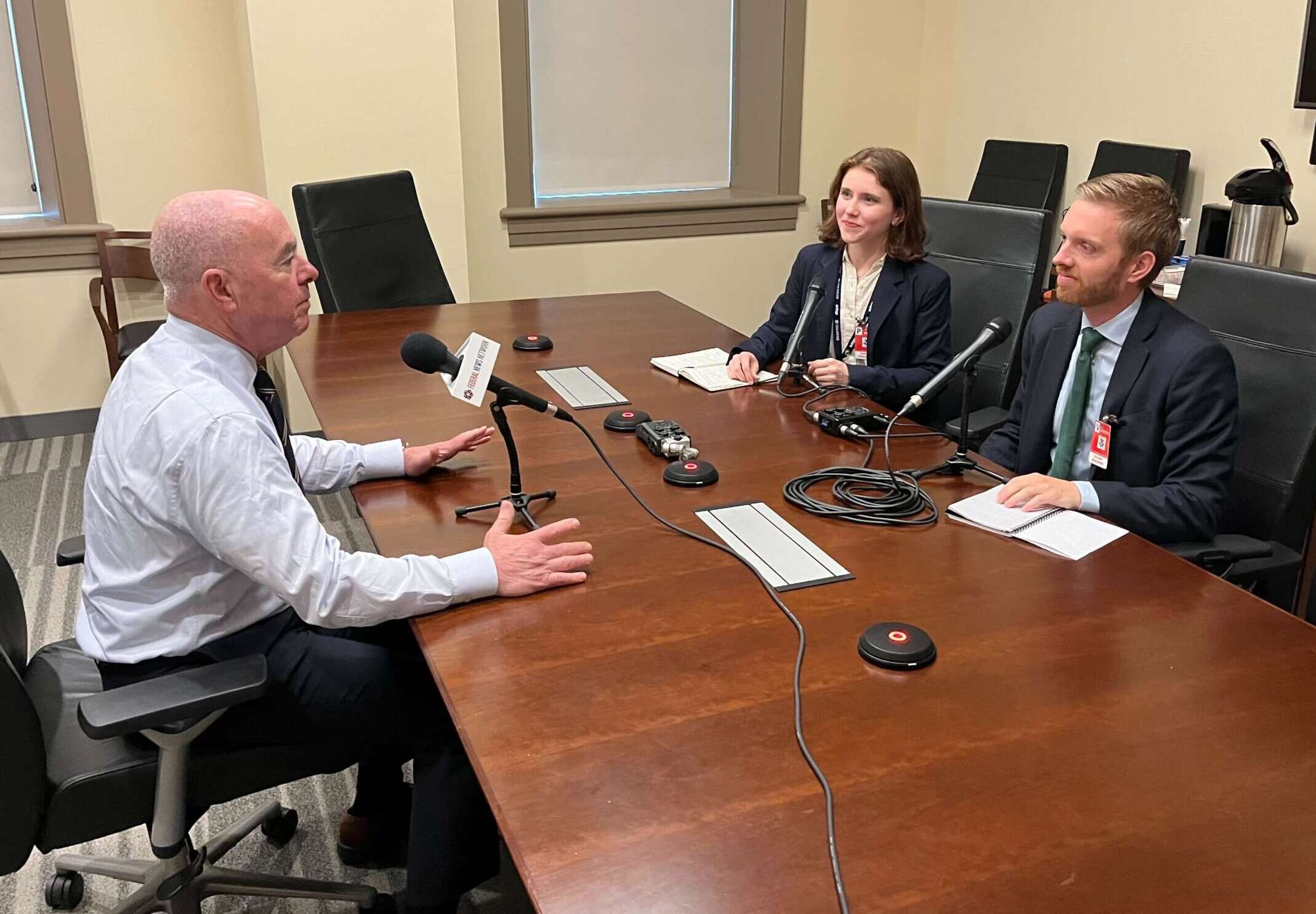
Several DHS components made improvements in their 2023 Best Places to Work rankings, most notably the Transportation Security Administration. TSA saw a more than 12-point boost in its employee engagement and satisfaction score, bolstered by a historic pay increase for airport screening officers that began in 2023.
On the other hand, several DHS components still struggle with employee morale. Customs and Border Protection and Immigration and Customs Enforcement, for instance, are two major frontline organizations that continue to place close to the bottom of the Partnership’s subcomponent rankings.
Out of the 459 agency subcomponents on the Partnership’s list, CBP ranked as number 432, while ICE came in as number 437.
“I think we have to be very clear-eyed and fair in understanding some of the pain points,” Mayorkas said.
The Best Places to Work series, based on data from the Federal Employee Viewpoint Survey (FEVS), shows that DHS performed well on questions related to the agency’s mission and supervisors, but received the most negative feedback from employees regarding their views on management decisions and performance recognition.
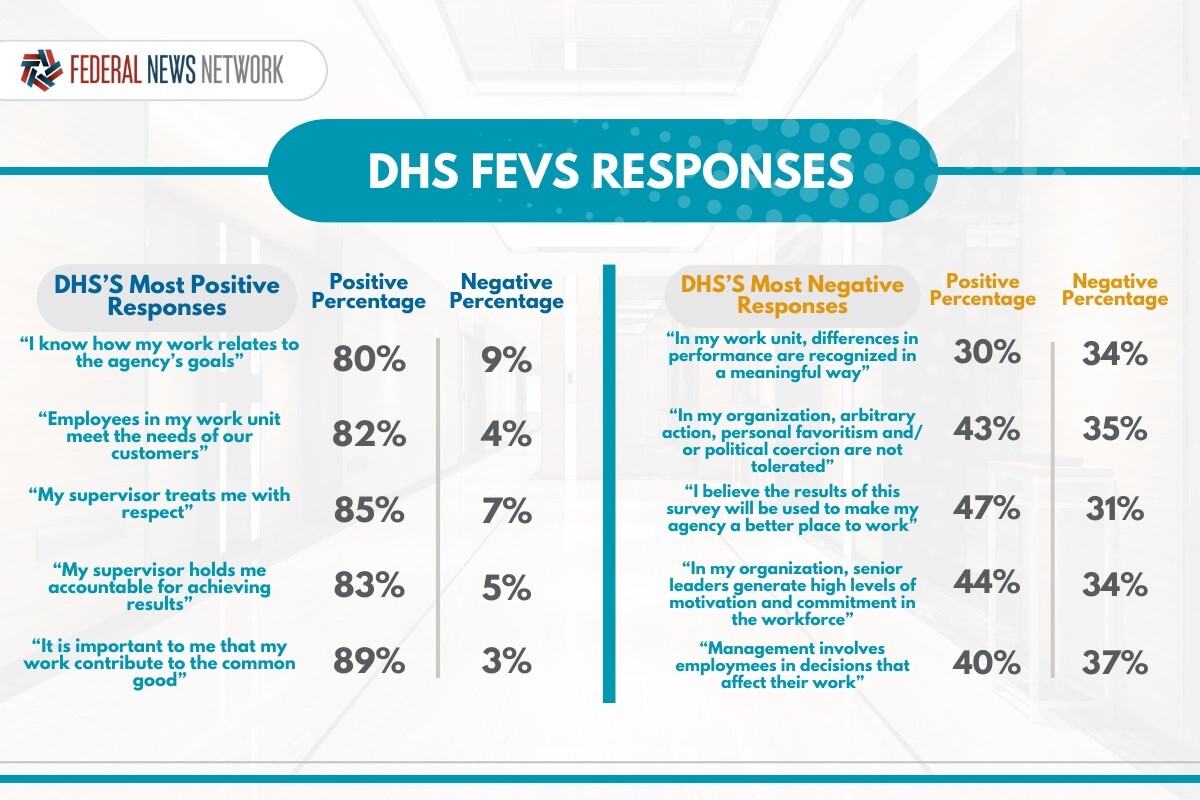
DHS jump teams aim to resolve problems quickly
Despite the uptick in its overall ranking, DHS is still struggling in a few key areas that the Partnership measures, such as employee input and recognition. Departmentwide, DHS received a score of 50 out of 100 on employee input, and 47.4 out of 100 on recognition. Both scores fall into the lowest quartile amid agencies featured in the Partnership’s rankings.
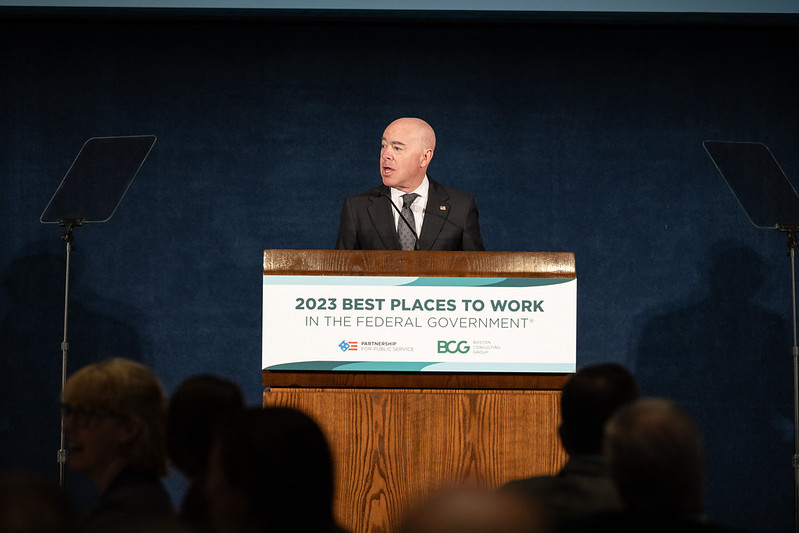
One way DHS is attempting to combat some of those ongoing challenges is by deploying “jump teams” to try to address concerns from frontline employees more quickly and effectively.
“Jump team members are responsible for helping to solve immediate issues, guide how funding is allocated and to assist in developing solutions to deliver support most effectively to our front line,” DHS explained in a May 20 press release.
Mayorkas, who’s responsible for initiating the jump teams, said the idea came after he visited a CBP facility in Miami, Florida, early in his tenure — a worksite that he called “woefully inadequate.”
“The employees who work there actually affectionately called it the ‘house of pain,’” Mayorkas said. “The lighting was poor, the connectivity was poor, some of the facilities were just awful.”
After the visit, DHS fixed the lighting, strengthened internet connections, along with adding many new amenities, such as a break room and fitness center, as well as upgrading the floors, ceilings, paint, furniture and roof. DHS held a ribbon-cutting ceremony for the new facility in April.
“The principle really underlying [that] is that we don’t have a monopoly on what the workforce needs,” Mayorkas said. “We want to hear directly from them and involve them as a team in addressing the challenges.”
Improving DHS recruiting and hiring
One of Mayorkas’ major priorities this year is improving the hiring process. Staffing has been a challenge at several DHS components, including CBP and ICE. The DHS inspector general last year reported on how staffing challenges at those agencies has led to burnout and morale issues amid rising migrant encounters at the southwest border.
Mayorkas acknowledged the hiring process at DHS can take a long time, especially for positions that require a security clearance and a polygraph exam.
“Without curtailing security thresholds, we can drive a far greater amount of efficiency in those processes,” he said. “And we lose candidates, sometimes because of the length of time it takes to onboard them. That’s especially true in the in the tech sector, but also in law enforcement and elsewhere. And also, a vacant position is a drain on morale, because the work needs to get done. And that means others are shouldering more.”
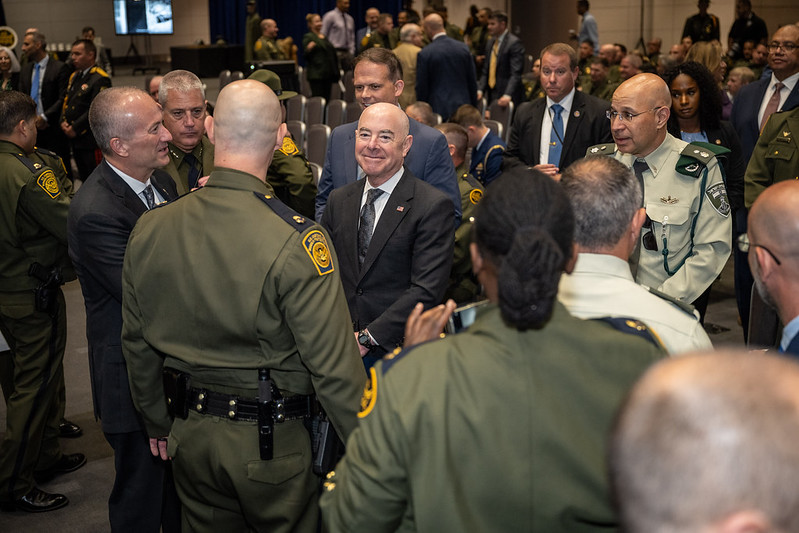
He said DHS is working on “innovative ways of recruiting talent.” During a recent two-day career expo in Chantilly, Virginia, DHS conducted more than 1,200 interviews and extended more than 400 tentative job offers. The career expo also let job candidates get started on some of the early steps of the clearance process, like fingerprinting, in an effort to reduce DHS’ time-to-hire by several weeks.
The department is additionally looking to hire from “places that we might not otherwise have gone to,” Mayorkas said. He pointed to DHS’ goal to have its law enforcement ranks comprise 30% women by 2030.
“We’re going to exceed that goal,” Mayorkas said.
Meanwhile, DHS has a long way to go toward improving “mobility,” or the ability of an employee to move between different jobs within the department.
“If somebody has been cleared, has received a security clearance in one agency, and they want to move to another agency, we still haven’t eliminated the redundancies entirely,” Mayorkas said.
DHS sees ‘tremendous’ interest in AI jobs
DHS is also putting all hands on deck to onboard more staff expertise in artificial intelligence and other emerging technologies.
In June, the department announced its first “AI Corps” cohort, comprising 10 new recruits with various AI expertise. DHS has more plans on the way to expand the program, aiming to recruit a total of 50 experts by the end of the year.
“It’s been tremendous,” Mayorkas said. “We see a greater thirst for public service in the tech sector.”
So far, there have been about 6,000 “expressions of interest” in AI Corps positions at DHS, Mayorkas said.
Soon, there may be even more opportunities opening for a broader array of candidates who are looking either at DHS or elsewhere across government for AI-related positions. The White House is aiming to shift federal tech positions in the government’s main IT job series away from relying on degrees, and instead focusing more on skills-based hiring.
Supervisor scores driving upward
One key part of improving engagement and satisfaction scores from DHS employees has been focusing on supporting agency managers and supervisors.
“Engagement begins at the top and must cascade throughout,” Mayorkas said. “Whether it is your first-line supervisor, which is where the rubber meets the road, but [also] upwards and sideways and every which way, it has to be cascading.”
DHS’ efforts to support supervisory employees are gradually starting to pay off. Employees’ views of their supervisors across DHS have continually increased, on average, over the last several years. Currently, DHS has a score of 77.4 out of 100 when it comes to agency supervisors.
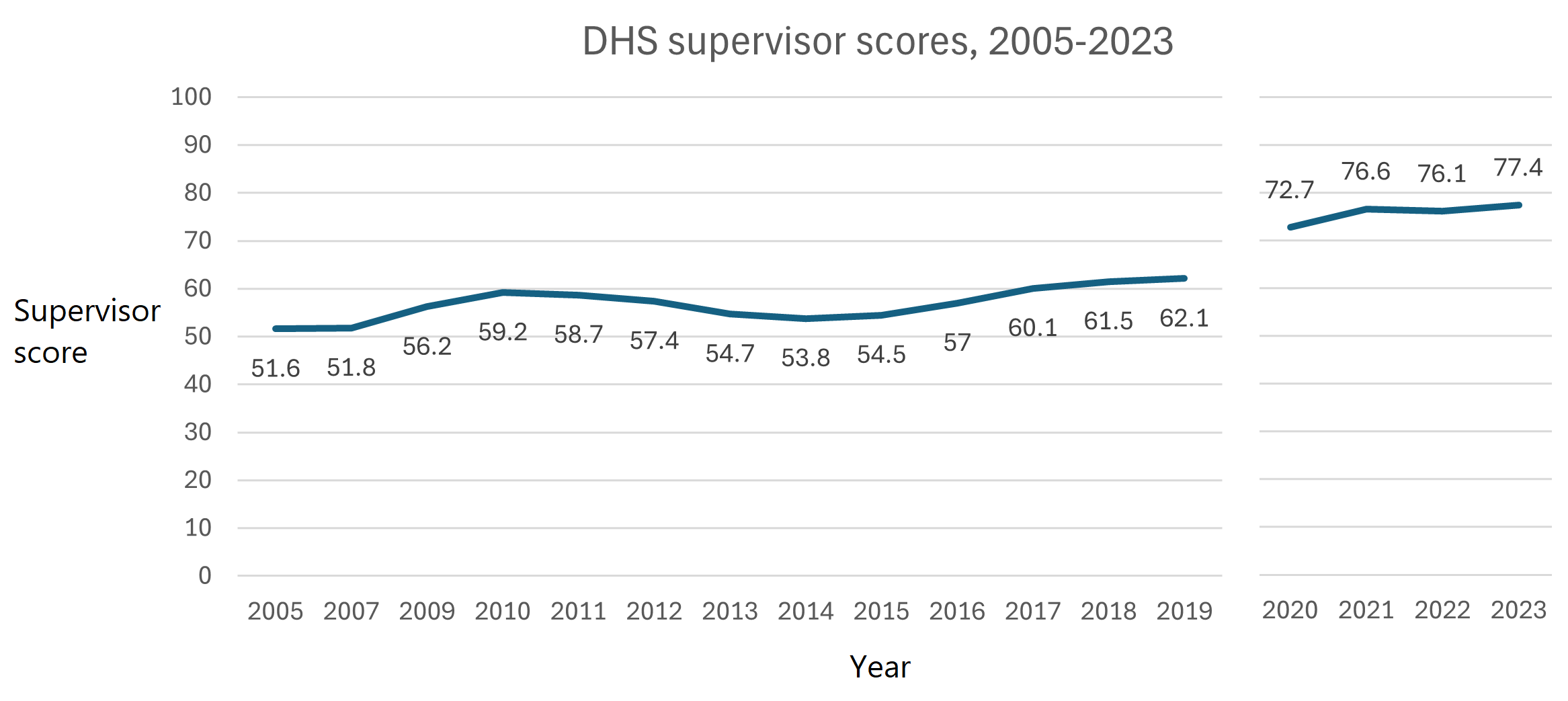
The ‘Patron Saint of Admin Leave’
Mayorkas has also been lauded online in places like the Fed News subreddit for his generous granting of administrative leave to DHS employees around the holidays. His affinity for giving extra time off to staff has even led some to jokingly dub him the “Patron Saint of Admin Leave.”
Most recently, Mayorkas doled out eight hours of paid administrative leave ahead of the Fourth of July holiday.
“It’s a small gesture of recognition and appreciation,” Mayorkas explained. “When one travels around the country and the world and sees how incredibly hard our people work and their unbelievable skill and talent, admin leave is a tool that I have to say, ‘We recognize that, we appreciate it. And here is an expression of gratitude.’”
Copyright © 2025 Federal News Network. All rights reserved. This website is not intended for users located within the European Economic Area.
Follow @jdoubledayWFED
Drew Friedman is a workforce, pay and benefits reporter for Federal News Network.
Follow @dfriedmanWFED






